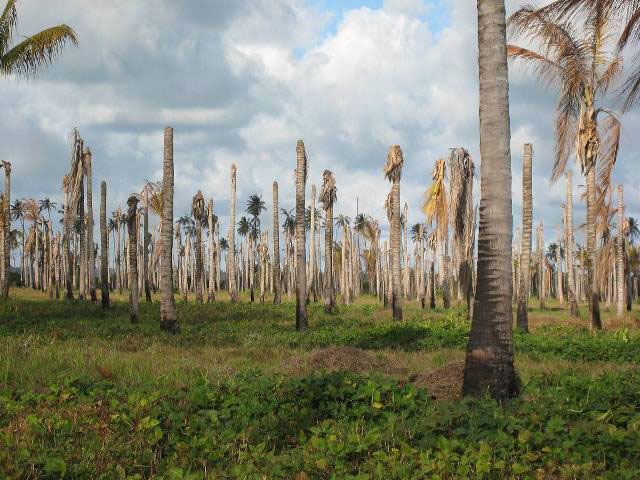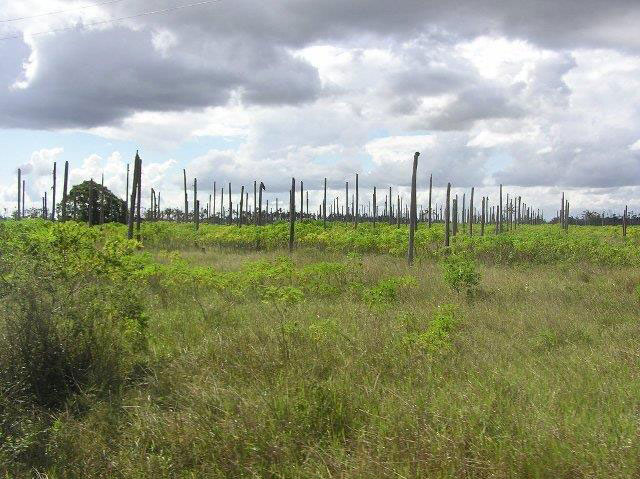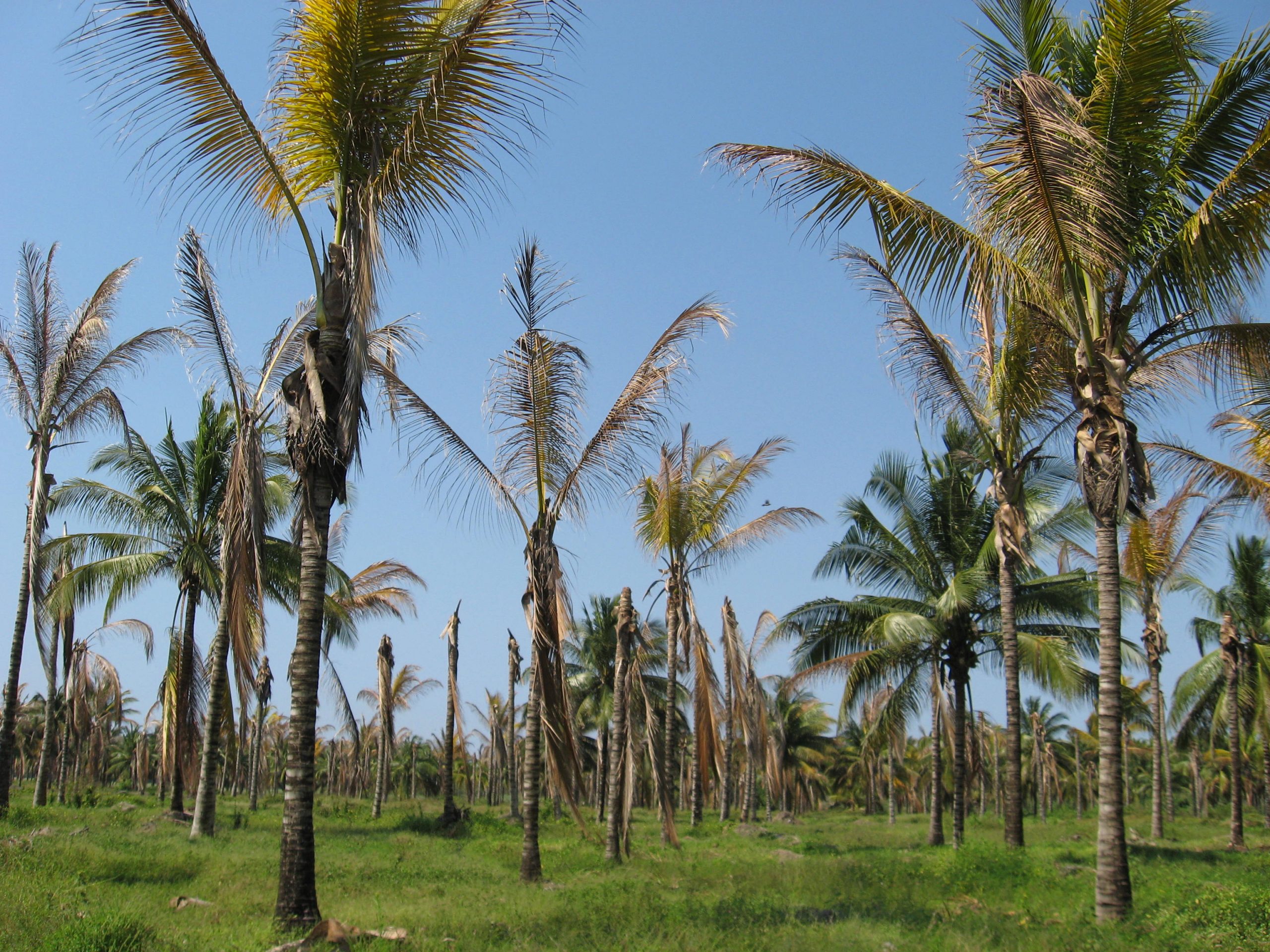Program Overview
MCC’s $506.9 million Mozambique Compact (2008-2013) funded the $18.9 million Farmer Income Support Project (FISP) to mitigate crop disease in treatment areas. FISP was based on the theory that rehabilitating high disease areas (endemic) by clearing dead trees and training farmers to plant alternative crops would lead to crop diversification; training farmers in disease control and removing diseased trees would stop crop disease in low disease (epidemic) areas; and planting seedlings in both areas along with providing business development grants to local businesses, would increase coconut production and its byproducts, leading to higher farm income.
Evaluator Description
MCC commissioned Abt Associates to conduct an independent final evaluation of the Farmer Income Support Project using both impact and performance methodologies. Full report results and learning: https://data.mcc.gov/evaluations/index.php/catalog/131.
Key Findings
Disease and Pest Control
- In the high disease (endemic) area, training on disease control resulted in project farmers being more likely to know cutting trees is a good way to mitigate disease, while training in the low disease (epidemic) area did not impact farmers’ knowledge of disease and pest control methods.
- In the epidemic area, the evaluation found trees were healthier and the disease spread rate was slower in treatment areas compared to the comparison area.
Replanting and Tree Survival
- In the endemic area, project households planted over three times as many disease-resistant coconut seedlings as comparison (8.5 vs. 2.3), with a lower seedling survival rate in the treatment area compared to comparison (43 percent vs. 61 percent).
- In the epidemic area, project households planted over twice as many disease-resistant coconut seedlings as comparison (3.6 vs. 1.8), with no statistical difference in the seedling survival rate (60 percent).
Coconut Production and Crop Diversification
- In the endemic area, project farmers were 70 percent more likely to plant alternative crops than comparison.
- In the epidemic area, project farmers produced 90 kgs more coconuts than comparison, but did not catch up to previous years’ production.
Farm, Non-Farm, and Household Incomes and Sustainability
- In the endemic area, there were negligible impacts on alternative crop sales revenue (an increase of only $0.15/yr per treatment household), and no significant impacts on farm income.
- In the epidemic area, there were no impacts on farm income, but project farmer annual household income increased 68 percent ($92.54) through an increase in non-farm income ($85.30).
- Sustainability of impacts were considered challenged (including an accelerated spread of CLYD in the future) by whether or not seedlings would prove disease resistant and whether or not cost-effective means for sustaining tree cutting could be identified.
Evaluation Questions
This final evaluation was designed to answer whether or not the Farmer Income Support Program training, tree removal and replacement, business grants, and research activities:
- 1
Reduced coconut lethal yellowing disease (CLYD) prevalence and spread rate? - 2
Increased coconut replanting? - 3
Improved survival rate of coconut seedlings? - 4
Increased coconut production? - 5
Increased the cultivation of alternative crops? - 6
Increased incomes of participating farmers in the endemic and epidemic areas?
Detailed Findings
Disease and Pest Control
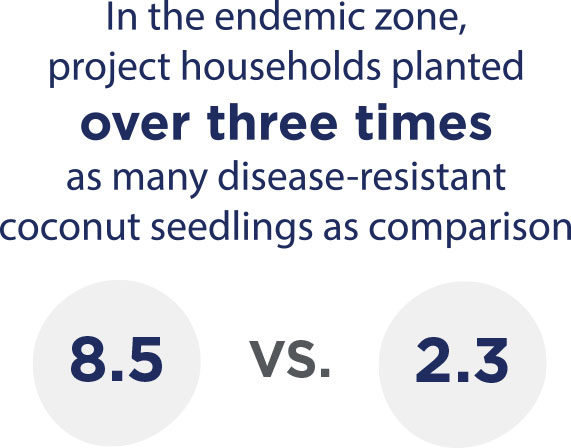
FISP efforts on disease and pest control focused on the epidemic area. According to the tree survey, there was an 18 point statistically significant higher prevalence of healthy trees in the treatment area compared to the comparison (43 percent compared to 26 percent). According to satellite imagery analysis, the tree coverage score remained between 35-45 percent in project areas, but dropped to below 10 percent in comparison areas by 2014. These findings suggest the activity slowed the disease spread rate in project areas, however the magnitude of the reduction was not very large. Additionally, less than 10 percent of farmers across all groups knew that cutting and burning the stumps is the best way to mitigate disease after FISP training.
Replanting and Tree Survival

FISP did not hit targets for replanting or tree survival in either the endemic and epidemic area. FISP aimed to distribute 28 seedlings per household on average in the endemic area, though results show 8.5 per household. In the epidemic area, FISP aimed to distribute 8 seedlings per household on average, though results show 3.7 per household. Additionally, FISP’s decision not to cut down or remove dead trees on private plantations in the epidemic area likely contributed to lower tree survival rate due to rhinoceros beetles which thrive in dead and diseased trees.
Coconut Production and Crop Diversification
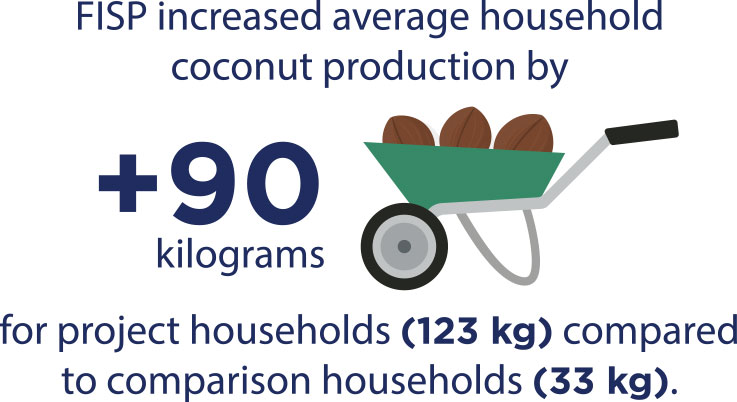
In the epidemic area, FISP increased average household coconut production by 90 kilograms for project households (123 kilograms) compared to comparison households (33 kilograms). Although positive, average production remained significantly lower than levels reported before coconut crop disease increased in 2009 (401 kilograms).
Farm, Non-Farm, and Household Incomes and Sustainability
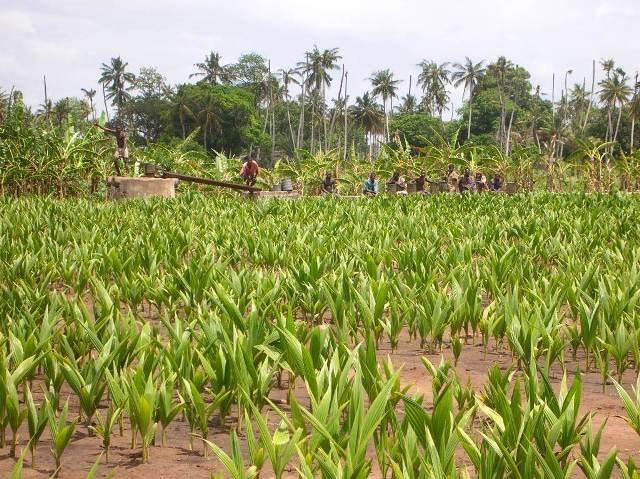
There were no impacts on farm income in either area. In the endemic area, FISP increased alternative crop income by $7, with no overall effect on farm income. However, in the epidemic area, increases in non-farm income ($85.30) were largely from fishing and non-skilled labor. These farmers earned on average $209.36 annually from non-farm sources, while households in comparison areas earned on average $123.27. FISP was not designed to have an impact on non-farm income, but the evaluator hypothesized FISP activities made farmers in these areas aware of the disease early and triggered them to diversify earlier compared to comparison. Lastly, the business development grant recipients in both areas perceived the program to be beneficial, however, no beneficiaries were able to provide information to quantify increases in sales, net income, or employment.
Economic Rate of Return
- 36%
MCC Original Estimate - 16.4%
Evaluation-Based Estimate
The evaluator’s revised cost-benefit analysis model produced a more modest overall economic rate of return (ERR) of 16.4 percent, compared to MCC’s end-of-project ERR estimate of 36 percent. The reduced ERR is driven by the higher observed disease prevalence rates and lower seedling survival rates than those anticipated by MCC at project closeout.
MCC Learning
Understand efficacy of design decisions before scale. For example, more scientific understanding was needed on whether or not clearing and removing trees was an appropriate method for mitigating disease spread and whether or not the coconut seedlings used for replanting were disease resistant.
Consideration of market forces is critical. FISP did not address broader market forces, such as trends in the coconut industry, farmers’ decisions to go off-farm, or formal linkages to new crop markets, that could support or detract from program aims.
Gender norms and constraints were important. Seedling care, planting, and care of alternative crops are often activities that women have to add on to their already burdened rural lives. These constraints were not considered during project design.
Evaluation Methods
The final evaluation used multiple impact and performance methodologies to estimate impacts of FISP. In the epidemic area, the impact evaluation used a geographic discontinuity design. In the endemic area, the impact evaluation used a matching method for selecting comparison areas that were very similar to the treatment areas at baseline, matching on disease prevalence and distance from the coast. To answer other evaluation questions, including the assessment of the grant facility and research activities, the evaluator conducted a performance evaluation using desktop review of project materials and case study approach.
The project was implemented in eight districts in Mozambique: Pebane, Moma, Angoche, Nicoadala, Namacurra, Maganja da Costa, Chinde, and Inhassunge. Implementation lasted from December 2009-December 2012, with final evaluation data collected in September-November 2014. This provided an exposure period of 21 – 57 months. The specific data collected and sample sizes were:
Quantitative Data in Nicoadala, Namacurra, Maganja da Costa, Chinde, and Inhassunge:
- Household surveys were conducted on 666 farmer households in 48 census enumeration areas (epidemic) and 561 farmer households in 80 census enumeration areas (endemic).
- 16,000 trees (epidemic) were sampled for direct observation.
- Satellite imagery was used to assess disease spread in 67,900 hectares from 2008-2014 for two matched census enumeration areas (epidemic) in Nicoadala and Inhassunge only.
Qualitative Data in all eight districts:
- 21 (epidemic) and 7 (endemic) focus group discussions with farmers.
- 13 (epidemic) and 7 (endemic) semi-structured interviews with farmers.
